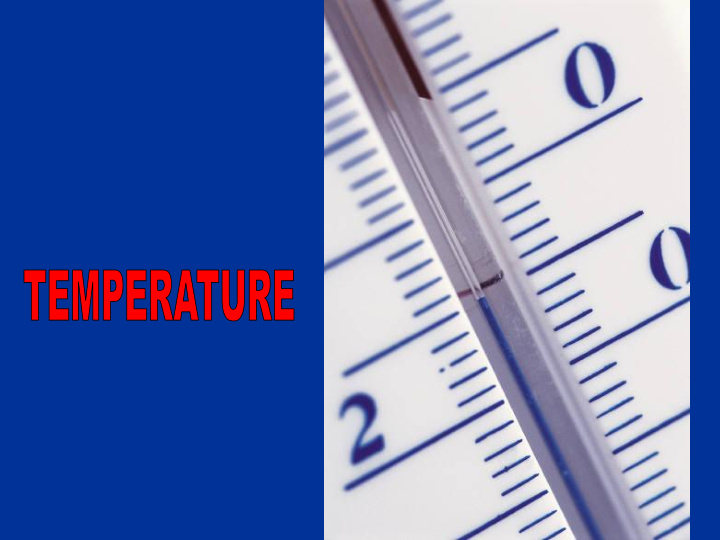



TEMPERATURE Definition: Measure of the average kinetic energy of the molecules in substance Therefore, the faster the speed, the higher the temperature
TEMPERATURE ICE WATER VAPOR 0ºF 212ºF Slower Molecules Faster Molecules
TEMPERATURE MEASUREMENTS Ahrens
High-altitude temperature plot Ahrens
GLOBAL AVERAGE SURFACE TEMPERATURE Your book When are the highest temperatures observed? WHY?
FACTORS AFFECTING TEMPERATURE Thus, it is not only the incoming solar radiation that controls the temperature of our planet What controls temperature? A. Incoming Solar Radiation, Tilt, Latitude B. Altitude (Elevation) C. Water Effects D. Surface Type and Aspect E. Weather
LATITUDE EFFECTS
LATITUDE EFFECT
Global Warming observed…
ALTITUDE EFFECT Temperature typically decreases with height in the troposphere... ...this rate of decrease ( LAPSE RATE ) is ~3.6°F every 1000 feet or 6.5°C every 1000 meters.
Temperature decreases 5000 6.5°C every 1000 m. 0 Cold Warm
ALTITUDE EFFECT
ALTITUDE EFFECT • Temperature typically decreases with height in the troposphere... EXCEPT during a TEMPERATURE INVERSION (calm, clear mornings) OFTEN LEADS TO POOR AIR QUALITY
WATER EFFECTS There are two different effects of water on temperature: 1) Proximity to large bodies of water 2) Proximity to ocean currents
WATER EFFECTS – PROXIMITY TO LARGE BODIES OF WATER • The specific heat capacity of water is greater than that of land. Water will heat/cool a lot slower than land . It takes more energy to heat/cool water than land. • During winter: land is colder than ocean • During summer: land is warmer than ocean
PROXIMITY TO LARGE BODIES OF WATER LAND TEMPERATURES EXHIBIT MORE SEASONALITY
PROXIMITY TO LARGE BODIES OF WATER LAND TEMPERATURES EXHIBIT MORE SEASONALITY
MAJOR OCEAN CURRENTS
PROXIMITY TO OCEAN CURRENTS
PROXIMITY TO OCEAN CURRENTS
USA TEMPERATURE RECORDS
USA TEMPERATURE RECORDS
Trenton Temperature Normals
QUESTION • Why is the maximum daily temperature for Trenton reached in the end of July/beginning of August and not on June 23 (Summer Solstice)? • Heat Capacity of Land and Air
The Urban Heat Island Effect at Fairbanks, Alaska by N. Magee,1 J. Curtis,2, G. Wendler,2 (1) Permanent address: Penn State University, 502 Walker Building, University Park, College Station. PA 16802-5013 (2) Geophysical Institute University of Alaska Fairbanks, Alaska 99775 Abstract: Theoretical & Applied Climatology (Vol. 64, pages 39-47) Using surface observation comparisons between Fairbanks and rurally situated Eielson Air Force Base in Interior Alaska, the growth of the Fairbanks heat island was studied for the time period 1949-1997. The climate records were examined to distinguish between a general warming trend and the changes due to an increasing heat island effect. Over the 49-year period, the population of Fairbanks grew by more than 500%, while the population of Eielson remained relatively constant. The mean annual heat island observed at the Fairbanks International Airport grew by 0.4°C, with the winter months experiencing a more significant value of 1.0°C. Primary focus was directed toward long-term heat island characterization based on season, wind speed, cloud cover, and time of day. In all cases, minimum temperatures were affected more than maxima and periods of calm or low wind speeds, winter clear sky conditions, and nighttime exhibited the largest heat island effects.
TEMPERATURE CYCLE – WEATHER AND THE DIURNAL CYCLE • Besides varying from month to month and day to day, the temperature at any location also varies within a day. For example, we all know that daytime is usually warmer than nighttime. • Furthermore weather factors such as: advection, clouds and sun, precipitation, and humidity all affect temperature
DIURNAL TEMPERATURE CYCLE • Maximum daily temperature is usually reached in the afternoon • Minimum daily temperature is usually reached right before sunrise
DIURNAL TEMPERATURE CYCLE
TCNJ, Month to date
Recommend
More recommend